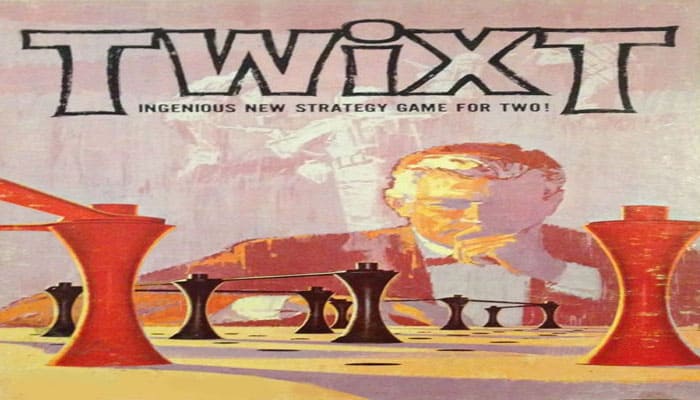

Components
- 4 TwixT board tiles
- 48 pegs of each color
- 48 connector fences of each color
- Instructions
Game Terms
Red - player or team using red pegs and links to connect the two red borders.
Black - player or team using black pegs and links to connect the two black borders.
Border Row - the outermost row of holes beyond a colored border; a player cannot peg his oppo- net's border row.
Privilege - the play in Double TwixT which permits a team to make two successive moves.
Barrier - a link placed between two pegs; a barrier cannot be crossed. A row of unlinked pegs is not a barrier.
Twix - the basic linking move, i.e., a peg placed linking distance away from a previously placed peg (distance corresponding to the diagonal of a 6-holed rectangle, similar to the knight's move in chess) in order to link the two pegs.
Double - Link-to place a peg the linking distance away from two previously placed pegs, permitting the player to link all three pegs in the same move.
Setup - a planned pattern of pegging which permits the player to double-link in either of two directions.

Basic Setups
A setup is a planned pattern of pegging which permits the player to double-link in either of two directions during the third move.

Pegs are numbered in order of placement. In the third move of any setup, a player can both peg and double-link.
Generally, it is easier to concentrate on the placement of the second peg, rather than the whole pattern. If the second peg is placed the correct distance from the first, the alternate locations for the third peg will be obvious.
The most important part of the strategy of a setup is to avoid wasting a move. Do not place the third peg until your opponent moves to bar one of your linking alternatives. Instead, concentrate on building another section of your barrier.
A setup can be foiled if the other player moves to block it immediately after the first peg of the setup is placed. Such foils are extensive; some possibilities are indicated by x on the diagrams. A well- placed Twix move is the simplest foil for a setup.
Twixt for Two Players
-
Red plays first. Players move alternately by placing one peg at a time on the board. Pegs may be placed by a player in any empty peg hole except those in his opponent's border row.

-
When, after he has placed a peg, a player finds that he can link two or more of his pegs, he may place one or more links between these pegs to make a barrier.
Pegs may be linked only when the distance between them corresponds to the diagonal of a 6-holed rectangle (see TERMS, "Twix" and "Double-Link").

Twixt - the basic linking move

Eight possible linking directions from a given peg

Double-Link (numbers indicate order of placement)
A barrier cannot be crossed. No barrier exists where a player could have linked but did not-whether the omission was intentional or unintentional.
Before placing a peg, a player may, if he desires, carefully remove any pegs and links he has previously placed on the board.
However, he should be certain not to remove any pegs and/or links which would give his opponent the advantage.
-
To win, a player must connect his borders with an uninterrupted chain of linked pegs. If neither player can complete such a barrier, the game is a draw.

Double Twixt for Four Players
Double TwixT is TwixT for four players in teams of two. Rules are the same as for TwixT, with the following qualifications:
-
Partners sit opposite one another. Play alternates counter-clockwise around the board.
-
No partner is limited to any one sector of the TwixT board: partners may play the two ends of a common barrier, or they may build independent sectors on any part of the board. Partners may not communicate strategies to one another by any form of signaling.
-
Once, and only once in each game, one partner of either team may call out, "Privilege I" after making his own move. On claim of Privilege, the opponent who would ordinarily move next must yield his turn to the other member of the "Privileged" team, giving the Privileged team two successive plays.
The player' to move next will be the partner of the opponent who yielded his turn. If the opponents have not been defeated by the Privilege move, they may take their own Privilege at that point or later in the game.
Privilege is invoked primarily for defensive reasons. If this option is carefully planned by well-matched teams, it can make Double TwixT a fast, challenging game.
Continue Reading

